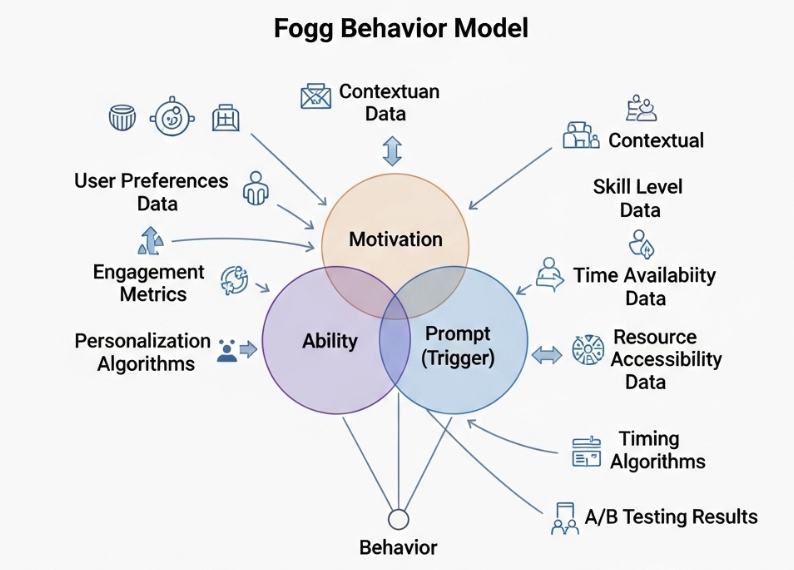As marketers, we’re all asking the same question: “Why do people choose to do what they do?” Why do they click one ad and not another? Why do they stick with one brand for years? The answer often feels like a mystery.
But what if it wasn’t?
Enter the Fogg Behavior Model, a groundbreaking framework from Stanford behavior scientist Dr. BJ Fogg. It’s a simple but powerful equation that explains human action: Behavior = Motivation + Ability + Prompt.
For any behavior to happen—whether it’s buying your product or signing up for a newsletter—these three things must happen at the same time. If one is missing, the action won’t happen. It’s that simple.
Let’s break it down.
The Three Pillars of Behavior
Motivation: This is the “why.” It’s your customer’s desire or willingness to act. People are generally motivated by:
- Sensation: Seeking pleasure and avoiding pain.
- Anticipation: Hoping for something good (like a great deal) or fearing a bad outcome (like missing out).
- Belonging: The need to be accepted and part of a community.
Ability: This is the “how easy.” The simpler something is to do, the more likely people are to do it, even if their motivation is low. Think about:
- Time: How long does it take?
- Money: How much does it cost?
- Effort: Is it mentally or physically draining?
Prompt: This is the “Go!” signal. It’s the trigger that tells your customer to “do it now.” This could be a “limited time only” banner, a “one-click to buy” button, or a simple email reminder.
The Old Way vs. The Smart Way
For years, marketers have used these principles without even knowing it. Think of Dollar Shave Club. They saw that people were motivated by the pain of expensive razors. They made it incredibly easy (high ability) to get affordable razors delivered to your door. And their viral video was the prompt that started it all.
This is great, but it’s based on intuition. It’s making an educated guess about what motivates people and what’s easy for them.
The Secret Sauce: Supercharging the Fogg Model with Data
This is where a data-driven approach changes the game. Instead of guessing what your customers want, you can know. Data is the secret ingredient that makes the Fogg Model work smarter, not harder.
Data-Driven Motivation:
Stop guessing what your audience hopes for or fears. Use data to find out.
- What it looks like: A/B testing different headlines to see which emotional angle gets more clicks. Using social listening to understand the “pain points” your customers are talking about. Analyzing survey data to see what features they value most.
- The result: You can tailor your messaging to what truly motivates your specific audience, not just what you think motivates them.
Data-Driven Ability:
Is your checkout process too complicated? Are your forms too long? Don’t guess. Data will tell you.
- What it looks like: Using website analytics to see where users drop off in the conversion funnel. Watching session recordings to see where they get stuck or confused. Using heatmaps to see which buttons they aren’t clicking.
- The result: You can pinpoint the exact friction points and simplify the process, making it easier for customers to act, which directly leads to higher conversion rates.
Data-Driven Prompts:
When is the perfect moment to ask for the sale or the sign-up? Sending a prompt at the wrong time is just noise.
- What it looks like: Segmenting your email list to send targeted offers based on past purchase behavior. Using website data to trigger a pop-up chat window when a user has been on the pricing page for more than a minute.
- The result: You deliver the right prompt to the right person at the exact moment they are most likely to convert.
It’s Not Magic, It’s Data
The Fogg Behavior Model provides the map, but data provides the turn-by-turn directions. By combining this powerful understanding of human behavior with the concrete insights of data, you’re no longer just marketing. You’re building a system that predictably and effectively encourages customers to act.
So, take a look at your marketing strategy. Are you just guessing what your customers want? Or are you using the data to build a system that works?
